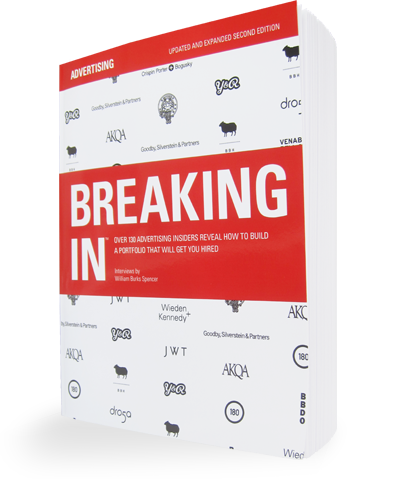Check out the work of Mark Harricks.
What do you look for in a student portfolio? And what impresses you?
For a student portfolio I’m not overly fussed about the craft side of things. I’m more interested in whether there are interesting ideas that are coming through. Actually, what’s more important for me is what the person is like. I get a much better sense when I meet someone whether it’s someone I would want to work with. And what I look for is feisty, interesting characters. Not people who are submissive or too amenable—you want creatives who have their own mind. Not someone who is going to sit in the corner and do what they’re told. I want people who can think on their feet and show initiative.
In terms of the book, as long as I can see they have the capacity to think of ideas and translate that into an ad of some kind, that’s the most important thing. If someone shows a few neat ideas and interesting insights, then I’ll say, “Let’s get them in and have a chat.” And then I find the meeting more important. I’d rather get someone in and work with them to help them grow and become a creative.
You mentioned craft isn’t so important to you. Could sketches be enough?
It’s very important to me now, but when I was starting out, my book was hand-drawn. I’m an art director who came from a typography/design background. What I wanted people to hire me for was my ideas. I really wanted to separate the fact that I could art-direct and do typography—because I had a whole book of that stuff—from my ideas and insights. So for me, sketches are fine when you’re starting out.
If someone does choose to craft things up, and it is really beautiful, then that’s cool, as long as they’ve got great ideas. If their thinking isn’t great, then it makes it a lot harder to hire them. If we had a great copywriter who was a great conceptual thinker I might try them together. But, the first thing I would want to see is still ideas. Because we’ve got people here who can do that [design], and I love that stuff so I can help people grow that side of themselves.
[ … ]
For writers, do you want to see long copy or evidence of writing ability?
Copy is a bit different; we can cover for an art director, we’ve got designers and typographers, but a copywriter needs to be able to show a gift for writing. So, when a writer comes through I’ll spend a bit more time reading the copy because that’s a skill that is very hard to cover for.
There aren’t very many really good copywriters. I don’t think it’s something that, at a junior level, we really cultivate. So it’s almost something that happens by accident. I don’t think we do a good job teaching that, as an industry.
Are there any common mistakes that students make?
From the moment a candidate walks in the door, you’re assessing them as someone you would work with and put in the department. So it’s the clothes and the hair and the way they mount their book. And you’re asking yourself, “Are they taking themselves seriously? Do they really want to do this? Are they putting in the effort?” I’ve had kids come in with a shopping bag and scraps of paper, and, if the ideas had been brilliant I would have forgiven the presentation and just thought they were a mad bastard. But they were the same sorts of ideas as everyone else, and he didn’t have anything interesting to say about his work. So put a bit of effort into making yourself look good and presenting your work. If you’re showing to an art director, don’t have double spaces in your copy—art directors will just think, “All these little mistakes make me think you don’t care about your work.” You can really undo yourself in an interview, and you just want to show that you’re smart and creative, that you have a few things going on in your life, that you can talk about all the pieces in your book…you should never have that dead silence in an interview. You should have something worked out to say for every piece in your book.
[ … ]

Mark Harricks

Comments are closed.